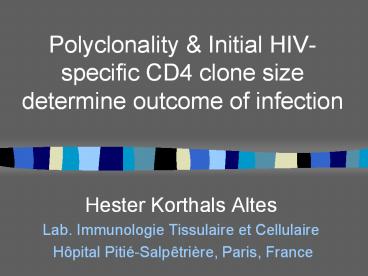Polyclonality PowerPoint PPT Presentation
Title: Polyclonality
1
Polyclonality Initial HIV-specific CD4 clone
size determine outcome of infection
- Hester Korthals Altes
- Lab. Immunologie Tissulaire et Cellulaire
- Hôpital Pitié-Salpêtrière, Paris, France
2
Observations
- Early events in HIV infection determine viral
setpoint and subsequent disease progression
(Staprans et al. 99, Lifson et al. 97) - Breadth of CD8 T cell repertoire correlates
negatively with progression (Pantaleo et al. 97) - Model HIV infection to explore how
- viral setpoint depends on
- ? CD4 helper clone size at infection
- ? Polyclonality of the response
3
HIV-specific CD4 HIV targets and mediators of
immune response
- Specific CD4 cells important targets of infection
- (Miedema et al. 88, Laurence et al. 89, and
- Douek et al. 02)
- Importance for priming and establishment of
memory CD8 response - (resp. Ridge et al. 98/ Livingstone Kuhn 99
and Borrow et al.) - Association CD4 T helper response with disease
progression / control - (Rosenberg et al., Pitcher et al. 99)
4
The model
5
The model / Mathematics
6
Characteristics of HIV-specific CD4 clones
- Clones differ in functional avidity
- ?1 responsiveness to Ag
- amount of antigen needed for half-
- maximum proliferation of H1.
- Responsiveness H2 scaled to responsiveness ?1 of
H1 (?2g?1). H1 is dominant, because ggt1. - Competition within clones
- Competition between clones only indirectly,
through Ag stimulation
7
MONOCLONAL SYSTEMVirus infectivity and outcome
of infection
No T helpers
Immune control 1 non-lytic clone
8
Initial events crucial
High initial H0 Immune control
Low initial H0 No Immune control
?0.05 T040 I01
9
MONOCLONAL SYSTEM Th avidity and outcome of
infection
No T helpers
Immune control 1 non-lytic clone
10
2 LYTIC CLONESTh avidity and outcome of
infection
No T helpers
1 lytic clone
2 lytic clones
11
2 DIFFERENT CLONESTh avidity and outcome of
infection
No T helpers
1 lytic clone
1 non-lytic, 1 lytic clone
12
Conclusions I
- Bistability Initial race between CD4 T helpers
and HIV can determine the outcome of infection
importance dual role CD4 H - - early therapy preserves CD4 and associated CTL
response against HIV (Oxenius et al., 2000) - - CD4 H induced by vaccination is beneficial
(Heeney 2002). - Probability of n-stability occurring highest with
only non-lytic or with specialised responses
(high-avidity lytic, low-avidity non-lytic)
13
Conclusions II
- Variation in viral setpoints can be ex-plained
by - n-stability across patients with same HLA-type
- differences in avidity of clones across patients
with different HLA-type - Implications for structured therapy
interruptions possible to stimulate extra clones
of intermediate avidity
14
Acknowledgements
- Rob de Boer
- Theoretical Biology, Utrecht University,
- the Netherlands
- Ruy Ribeiro
- Theoretical Biology and Biophysics,
- Los Alamos National Laboratories
- Research supported by a Marie Curie Fellowship
under the European Community Programme Quality of
Life

